Structural Properties and Electrical Characteristics of p-n Junctions Based on Kesterite Cu2ZnSnS4 Layers for Thin-Film Solar Cells
Abstract
:1. Introduction
2. Materials and Methods
3. Results and Discussion
4. Conclusions
Author Contributions
Funding
Institutional Review Board Statement
Informed Consent Statement
Acknowledgments
Conflicts of Interest
References
- Pachauri, R.K.; Allen, M.R.; Barros, V.R.; Broome, J.; Cramer, W.; Christ, R.; Church, J.A.; Clarke, L.; Dahe, Q.; Dasgupta, P.; et al. Climate Change 2014: Synthesis Report; Intergovernmental Panel on Climate Change, IPCC: Geneva, Switzerland, 2014; p. 151. [Google Scholar]
- MunichRE. Natural Disaster Risks: Losses are Trending Upwards. Available online: https://www.munichre.com/en/risks/natural-disasters-losses-are-trending-upwards.html (accessed on 5 January 2021).
- Allen, J.G.; MacNaughton, P.; Satish, U.; Santanam, S.; Vallarino, J.; Spengler, J.D. Associations of cognitive function scores with carbon dioxide, ventilation, and volatile organic compound exposures in office workers: A controlled exposure study of green and conventional office environments. Environ. Health Perspect. 2016, 124, 805–812. [Google Scholar] [CrossRef] [PubMed] [Green Version]
- Fraunhofer Institute for Solar Energy Systems, ISE with support of PSE Projects GmbH. Photovoltaics Report. Available online: https://www.ise.fraunhofer.de/content/dam/ise/de/documents/publications/studies/Photovoltaics-Report.pdf (accessed on 1 May 2020).
- Lee, T.D.; Ebong, A.U. A review of thin film solar cell technologies and challenges. Renew. Sustain. Energy Rev. 2017, 70, 1286–1297. [Google Scholar] [CrossRef]
- Delbos, S. Kësterite thin films for photovoltaics: A review. EPJ Photovolt. 2012, 3, 35004. [Google Scholar] [CrossRef]
- Ito, K.; Nakazawa, T. Electrical and optical properties of stannite-type quaternary semiconductor thin films. Jpn. J. Appl. Phys. 1988, 27, 2094. [Google Scholar] [CrossRef]
- Fan, M.S.; Chen, J.H.; Li, C.T.; Cheng, K.W.; Ho, K.C. Copper zinc tin sulfide as a catalytic material for counter electrodes in dye-sensitized solar cells. J. Mater. Chem. A 2015, 3, 562–569. [Google Scholar] [CrossRef]
- Rühle, S. Tabulated values of the Shockley-Queisser limit for single junction solar cells. Sol. Energy 2016, 130, 139–147. [Google Scholar] [CrossRef]
- Green, M.A.; Dunlop, E.D.; Hohl-Ebinger, J.; Yoshita, M.; Kopidakis, N.; Ho-Baillie, A.W.Y. Solar cell efficiency tables (version 55). Prog. Photovolt. Res. Appl. 2020, 28, 3–15. [Google Scholar] [CrossRef]
- Kumar, M.; Dubey, A.; Adhikari, N.; Venkatesan, S.; Qiao, Q. Strategic review of secondary phases, defects and defect-complexes in kesterite CZTS-Se solar cells. Energy Environ. Sci. 2015, 8, 3134–3159. [Google Scholar] [CrossRef]
- Dong, L.; Cheng, S.; Lai, Y.; Zhang, H.; Jia, H. Sol-gel processed CZTS thin film solar cell on flexible molybdenum foil. Thin Solid Film. 2017, 626, 168–172. [Google Scholar] [CrossRef]
- Agawane, G.L.; Kamble, A.S.; Vanalakar, S.A.; Shin, S.W.; Gang, M.G.; Yun, J.H.; Gwak, J.; Moholkar, A.V.; Kima, J.H. Fabrication of 3.01% power conversion efficient high-quality CZTS thin film solar cells by a green and simple sol-gel technique. Mater. Lett. 2015, 158, 58–61. [Google Scholar] [CrossRef]
- Wang, W.; Winkler, M.T.; Gunawan, O.; Gokmen, T.; Todorov, T.K.; Zhu, Y.; Mitzi, D.B. Device characteristics of CZTSSe thin-film solar cells with 12.6% efficiency. Adv. Energy Mater. 2014, 4, 1301465. [Google Scholar] [CrossRef]
- Özdal, T.; Kavak, H. Comprehensive analysis of spin coated copper zinc tin sulfide thin film absorbers. J. Alloy. Compd. 2017, 725, 644–651. [Google Scholar] [CrossRef]
- Khemiri, N.; Chamekh, S.; Kanzari, M. Properties of thermally evaporated CZTS thin films and numerical simulation of earth abundant and non-toxic CZTS/ZN(S, O) based solar cells. Sol. Energy 2020, 207, 496–502. [Google Scholar] [CrossRef]
- Borate, H.; Bhorde, A.; Waghmare, A.; Nair, S.; Pandharkar, S.; Punde, A.; Shinde, P.; Vairale, P.; Jadkar, V.; Waykar, R.; et al. Single-step electrochemical deposition of CZTS thin films with enhanced photoactivity. ES Mater. Manuf. 2021, 11, 30–39. [Google Scholar]
- Dimitrievska, M.; Fairbrother, A.; Fontané, X.; Jawhari, T.; Izquierdo-Roca, V.; Saucedo, E.; Pérez-Rodríguez, A. Multiwavelength excitation Raman scattering study of polycrystalline kesterite Cu2ZnSnS4 thin films. Appl. Phys. Lett. 2014, 104, 021901. [Google Scholar] [CrossRef] [Green Version]
- Valakh, M.Y.; Litvinchuk, A.P.; Dzhagan, V.M.; Yukhymchuk, V.O.; Havryliuk, Y.O.; Guc, M.; Bodnar, I.V.; Izquierdo-Roca, V.; Pérez-Rodríguez, A.; Zahn, D.R.T. Optical properties of quaternary kesterite-type Cu2Zn(Sn1−xGex)S4 crystalline alloys: Raman scattering, photoluminescence and first-principle calculations. RSC Adv. 2016, 6, 67756. [Google Scholar] [CrossRef] [Green Version]
- Saleem, M.F.; Zhang, H.; Deng, Y.; Wang, D. Resonant Raman scattering in nanocrystalline thin CdS film. J. Raman Spectrosc. 2017, 48, 224–229. [Google Scholar] [CrossRef]
- Zielony, E.; Płaczek-Popko, E.; Henrykowski, A.; Gumienny, Z.; Kamyczek, P.; Jacak, J.; Nowakowski, P.; Karczewski, G. Laser irradiation effects on the CdTe/ZnTe quantum dot structure studied by Raman and AFM spectroscopy. J. Appl. Phys. 2012, 112, 063520. [Google Scholar] [CrossRef]
- Scragg, J.J.; Wätjen, J.T.; Edoff, M.; Ericson, T.; Kubart, T.; Platzer-Björkman, C. A detrimental reaction at the molybdenum back contact in Cu2ZnSn(S,Se)4 thin-film solar cells. J. Am. Chem. Soc. 2012, 134, 19330–19333. [Google Scholar] [CrossRef] [PubMed]
- Yang, K.-J.; Sim, J.-H.; Jeon, B.; Son, D.-H.; Kim, D.-H.; Sung, S.-J.; Hwang, D.-K.; Song, S.; Khadka, D.B.; Kim, J.H.; et al. Effects of Na and MoS2 on Cu2ZnSnS4 thin-film solar cell. Prog. Photovolt. 2015, 23, 862–873. [Google Scholar] [CrossRef]
- Wu, J.-Y.; Lin, M.-N.; Wang, L.-D.; Zhang, T. Photoluminescence of MoS2 prepared by effective grinding-assisted sonication exfoliation. J. Nanomater. 2014, 2014, 1–14. [Google Scholar]
- Fernandes, P.A.; Salomé, P.M.P.; da Cunha, A.F. Study of polycrystalline Cu2ZnSnS4 films by Raman scattering. J. Alloy. Compd. 2011, 509, 7600–7606. [Google Scholar] [CrossRef] [Green Version]
- Windom, B.C.; Sawyer, W.G.; Hahn, D.W. A Raman spectroscopic study of MoS2 and MoO3: Applications to tribological systems. Tribol. Lett. 2011, 42, 301–310. [Google Scholar] [CrossRef]
- Płaczek-Popko, E.; Paradowska, K.; Pietrzyk, M.; Kozanecki, A. Carrier transport mechanisms in the ZnO based heterojunctions grown by MBE. Opto-Electron. Rev. 2017, 25, 181–187. [Google Scholar] [CrossRef]
- Shockley, W.; Queisser, H.J. Detailed balance limit of efficiency of p-n junction solar cells. J. Appl Phys. 1961, 32, 510. [Google Scholar] [CrossRef]
- Jain, A.; Kapoor, A. A new method to determine the diode ideality factor of real solar cell using Lambert W-function. Sol. Energy Mater. Sol. Cells 2005, 86, 197–205. [Google Scholar] [CrossRef]
- Wang, C.-X.; Yang, G.-W.; Liu, H.-W.; Han, Y.-H.; Luo, J.-F.; Gao, C.-X.; Zou, G.-T. Experimental analysis and theoretical model for anomalously high ideality factors in ZnO/diamond p-n junction diode. Appl. Phys. Lett. 2004, 84, 2427. [Google Scholar] [CrossRef]
- Zielony, E.; Płaczek-Popko, E.; Nowakowski, P.; Gumienny, Z.; Suchocki, A.; Karczewski, G. Electro-optical characterization of Ti/Au–ZnTe Schottky diodes with CdTe quantum dots. Mat. Chem. Phys. 2012, 134, 821–828. [Google Scholar] [CrossRef]
- Zielony, E.; Przezdziecka, E.; Płaczek-Popko, E.; Lisowski, W.; Stachowicz, M.; Paradowska, K.M.; Jakiela, R.; Kozanecki, A. Deep levels in the MBE ZnO:As/n-GaN diodes—Photoluminescence, electrical properties and deep level transient spectroscopy. J. Alloy. Compd. 2018, 742, 296–303. [Google Scholar] [CrossRef]
- Jain, A.; Kumar, P.; Jain, S.C.; Kumar, V.; Kaur, R.; Mehra, R.M. Trap filled limit voltage and V2 law inspace charge limited currents. J. Appl. Phys. 2007, 102, 094505. [Google Scholar] [CrossRef]
- Shyju, T.S.; Anandhi, S.; Suriakarthick, R.; Gopalakrishnan, R.; Kuppusami, P. Mechanosynthesis, deposition and characterization of CZTS and CZTSe materials for solar cell applications. J. Solid State Chem. 2015, 227, 165–177. [Google Scholar] [CrossRef]
- Li, J.B.; Chawla, V.; Clemens, B.M. Investigating the role of grain boundaries in CZTS and CZTSSe thin film solar cells with scanning probe microscopy. Adv. Mater. 2012, 24, 720–723. [Google Scholar] [CrossRef] [PubMed]
- Özdal, T.; Chtouki, T.; Kavak, H.; Figa, V.; Guichaoua, D.; Erguig, H.; Mysliwiec, J.; Sahraoui, B. Effect of annealing temperature on morphology and optoelectronics properties of spin-coated CZTS thin films. J. Inorg. Organomet. Polym. Mater. 2021, 31, 89–99. [Google Scholar] [CrossRef]
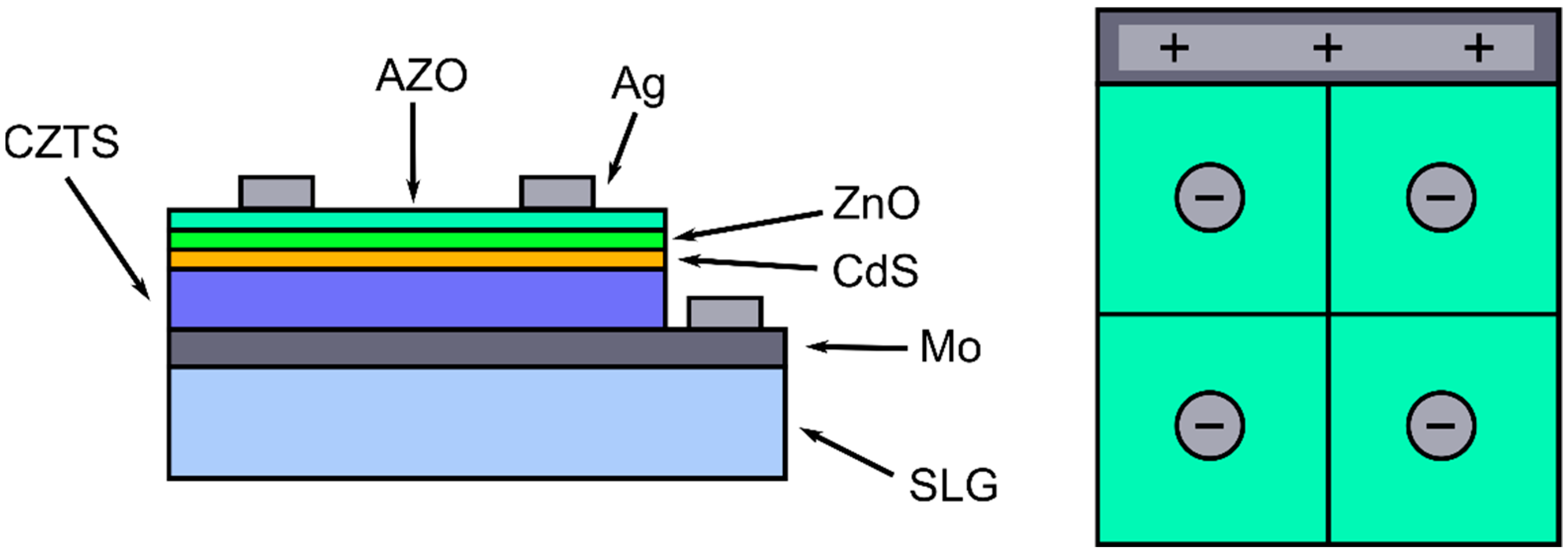

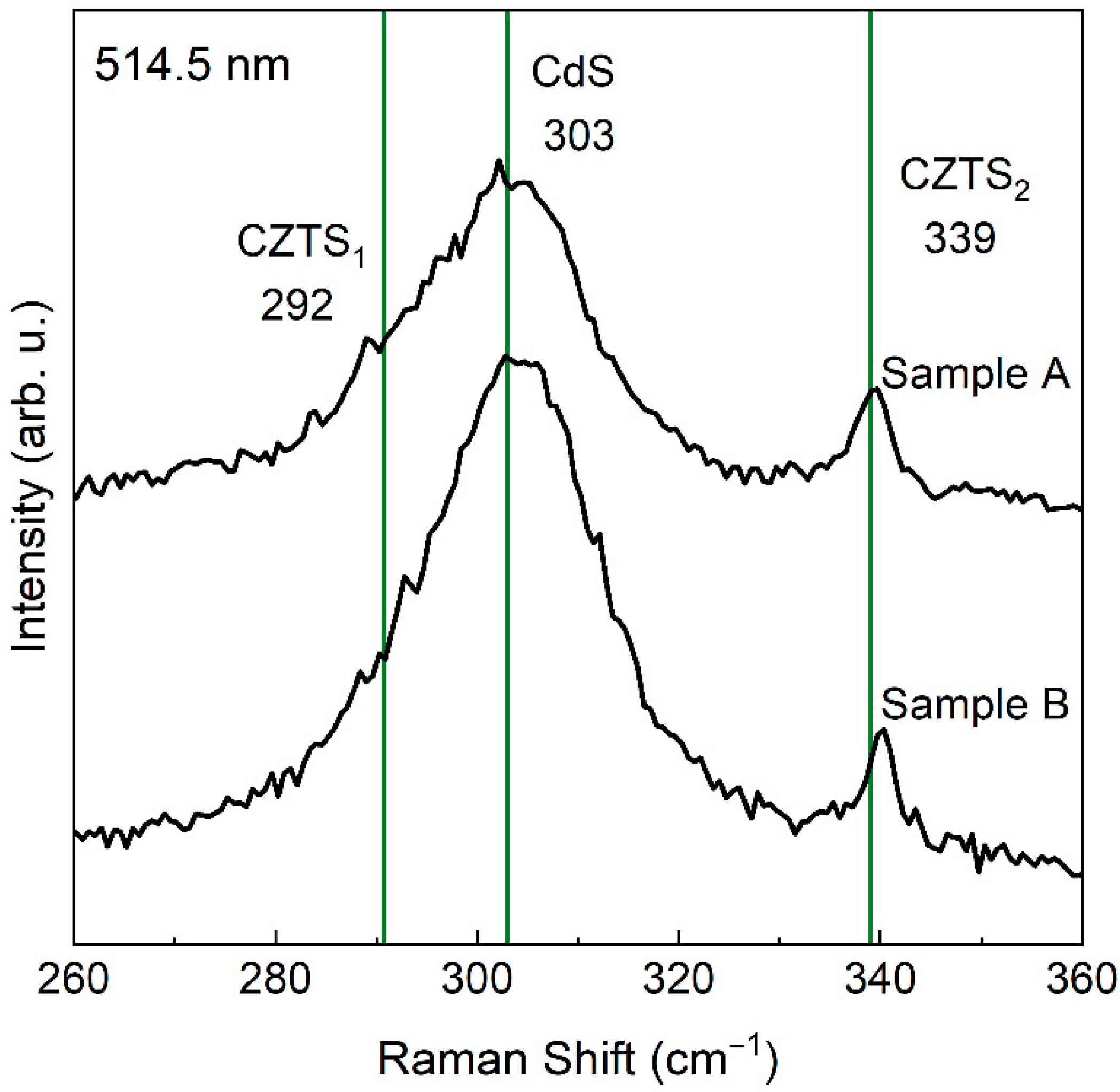


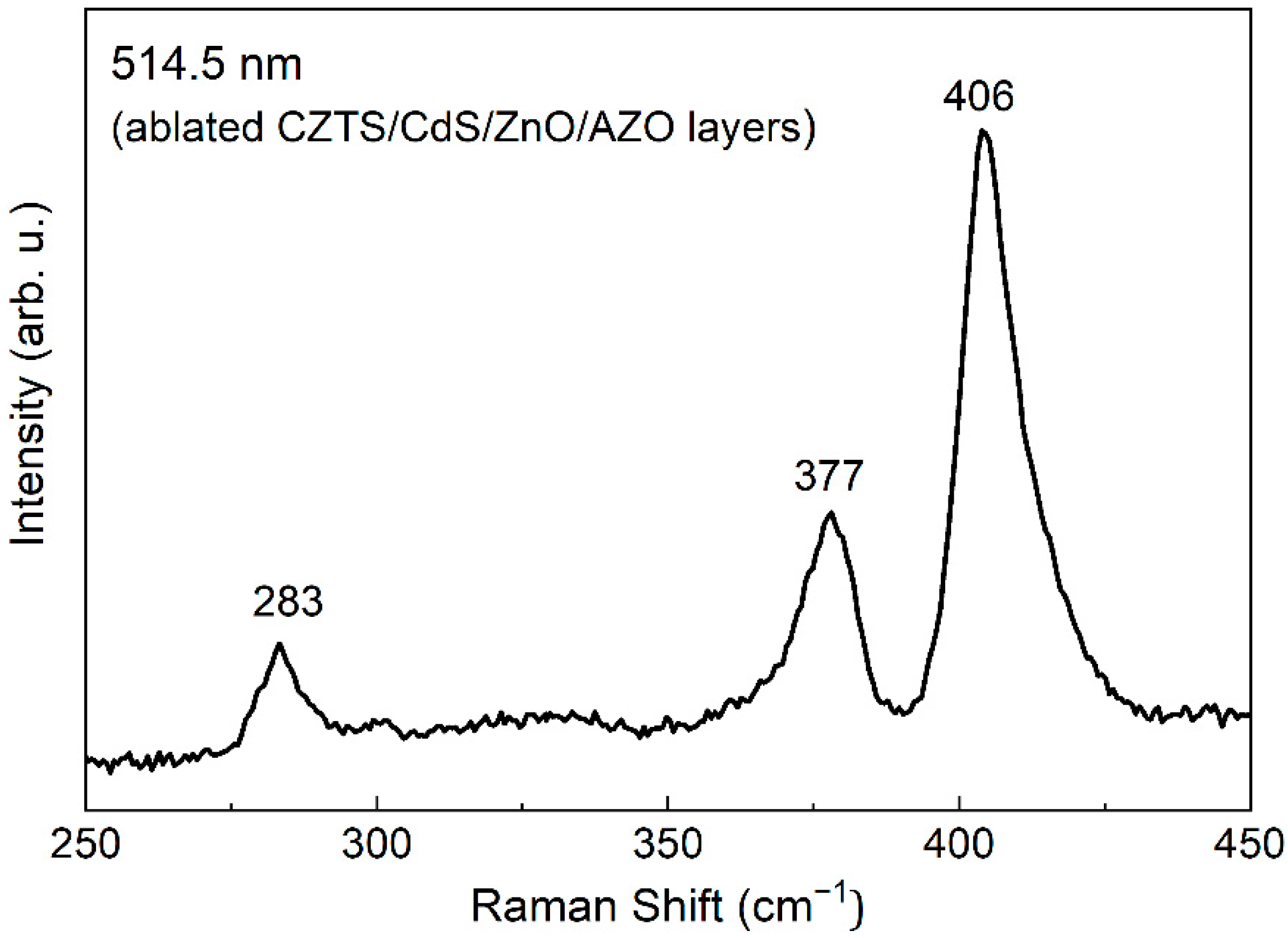
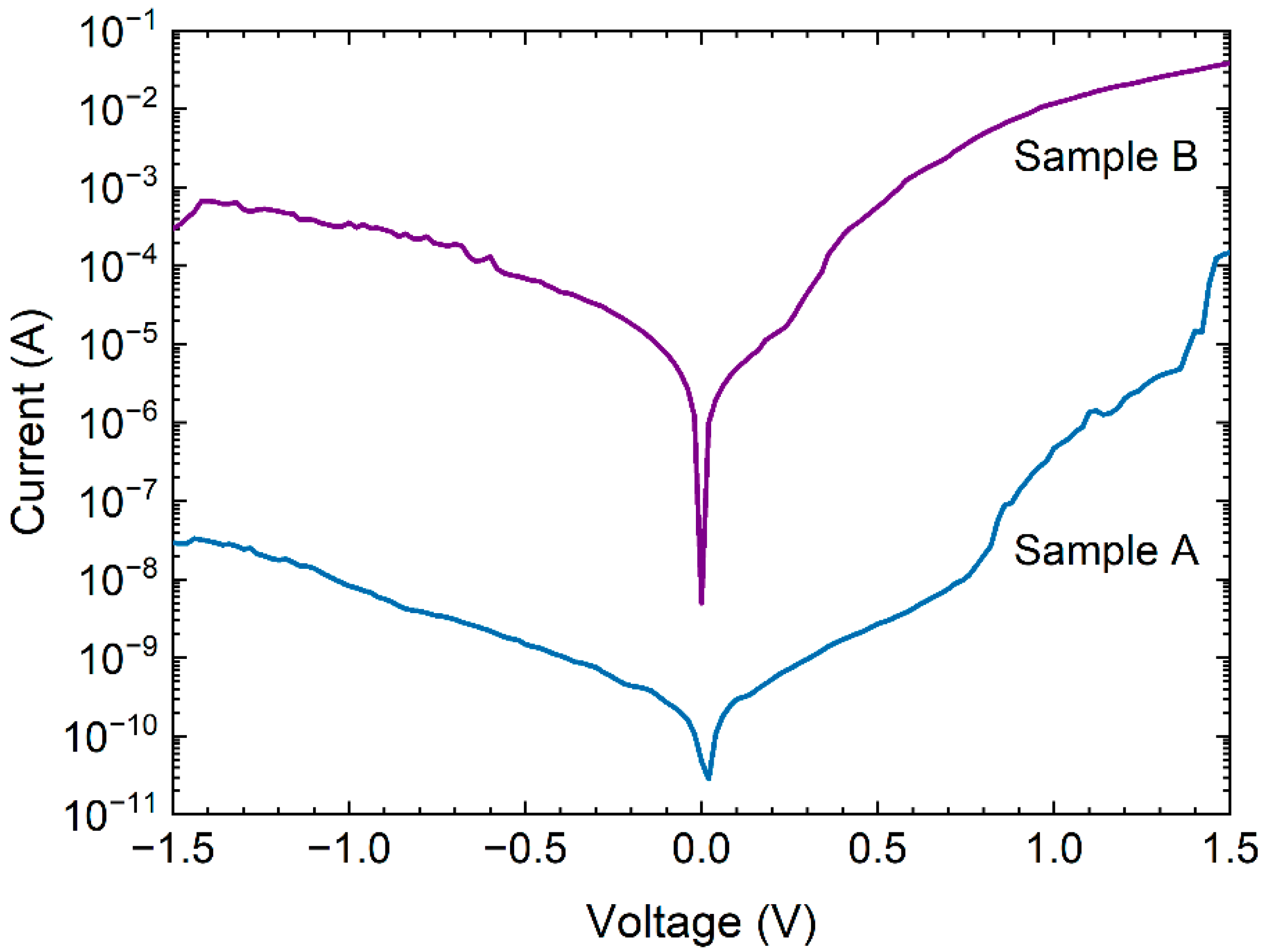

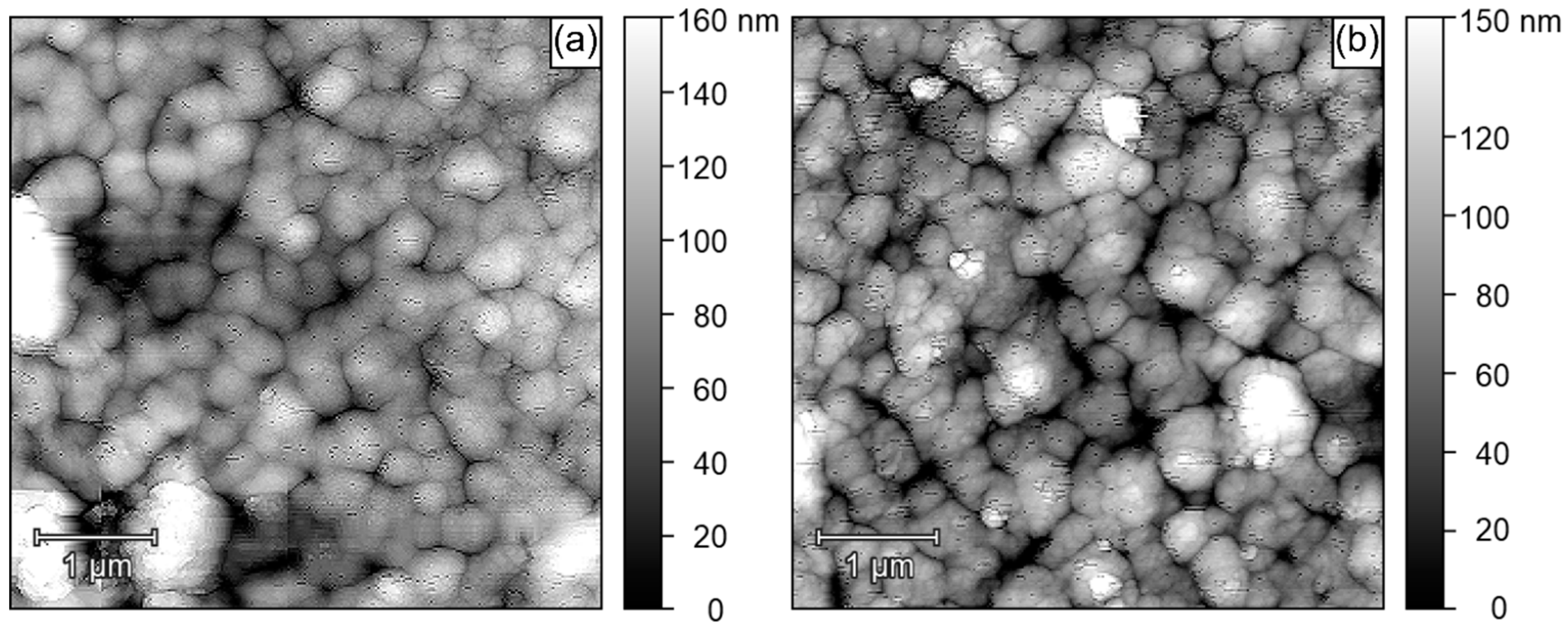
| CZTS1 | CdS | CZTS2 | |
|---|---|---|---|
| Mode: | A (LO) | LO | A (LO) |
| Sample A | 288 | 303 | 339 |
| Sample B | 296 | 303 | 340 |
| CZTS1 | CZTS2 | CZTS3 | |
|---|---|---|---|
| Mode: | A (LO) | A (LO) | B/E (LO) |
| Sample A | 285 | 336 | 367 |
| Sample B | 285 | 336 | 367 |
| Vbi (V) | Rs (Ω) | RR at ±1 V | n | |
|---|---|---|---|---|
| Sample A | 1.40 ± 0.31 | 633 ± 97 | 56.8 | 7.363 ± 0.073 |
| Sample B | 0.802 ± 0.032 | 18.90 ± 0.40 | 33.2 | 3.042 ± 0.071 |
| Sa | Sq | |
|---|---|---|
| (nm) | (nm) | |
| Sample A | 25 | 36 |
| Sample B | 21 | 29 |
Publisher’s Note: MDPI stays neutral with regard to jurisdictional claims in published maps and institutional affiliations. |
© 2021 by the authors. Licensee MDPI, Basel, Switzerland. This article is an open access article distributed under the terms and conditions of the Creative Commons Attribution (CC BY) license (https://creativecommons.org/licenses/by/4.0/).
Share and Cite
Perlikowski, I.; Zielony, E.; Özdal, T.; Kavak, H. Structural Properties and Electrical Characteristics of p-n Junctions Based on Kesterite Cu2ZnSnS4 Layers for Thin-Film Solar Cells. Energies 2021, 14, 5182. https://doi.org/10.3390/en14165182
Perlikowski I, Zielony E, Özdal T, Kavak H. Structural Properties and Electrical Characteristics of p-n Junctions Based on Kesterite Cu2ZnSnS4 Layers for Thin-Film Solar Cells. Energies. 2021; 14(16):5182. https://doi.org/10.3390/en14165182
Chicago/Turabian StylePerlikowski, Igor, Eunika Zielony, Teoman Özdal, and Hamide Kavak. 2021. "Structural Properties and Electrical Characteristics of p-n Junctions Based on Kesterite Cu2ZnSnS4 Layers for Thin-Film Solar Cells" Energies 14, no. 16: 5182. https://doi.org/10.3390/en14165182






